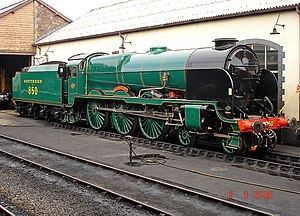SR Lord Nelson Class

No. 850 Lord Nelson as preserved
|
|||||||||||||||||||||||||||||||||
|
|||||||||||||||||||||||||||||||||
|
|||||||||||||||||||||||||||||||||
|
|||||||||||||||||||||||||||||||||
|
|||||||||||||||||||||||||||||||||
| Type and origin | |
|---|---|
| Power type | Steam |
| Designer | Richard Maunsell |
| Builder | SR Eastleigh Works |
| Build date | 1926–1929 |
| Total produced | 16 |
| Specifications | |
|---|---|
| Configuration: |
|
| • Whyte | 4-6-0 |
| • UIC | 2′C h4 |
| Gauge | 4 ft 8 1⁄2 in (1,435 mm) standard gauge |
| Leading dia. | 3 ft 1 in (0.940 m) |
| Driver dia. | 6 ft 7 in (2.007 m) 6 ft 3 in (1.905 m) (one-off modification on E859) |
| Length | 69 ft 9 3⁄4 in (21.3 m) |
| Total weight | 142 long tons 6 cwt (318,800 lb or 144.6 t) (159.4 short tons) |
| Fuel type | Coal |
| Fuel capacity | 5 long tons 0 cwt (11,200 lb or 5.1 t) (5.6 short tons) |
| Water cap | 5,000 imp gal (23,000 l; 6,000 US gal) |
| Firebox: • Firegrate area |
33 sq ft (3.1 m2) |
| Boiler pressure | 220 lbf/in2 (1.52 MPa) |
| Cylinders | Four |
| Cylinder size | 16 1⁄2 in × 26 in (419 mm × 660 mm) |
| Performance figures | |
|---|---|
| Tractive effort | 33,510 lbf (149.06 kN) 35,298 lbf (157.01 kN) (E859 w/6 ft 3 in. driving wheels) |
| Career | |
|---|---|
| Operators | |
| Power class | BR: 7P |
| Locale | Great Britain |
| Withdrawn | 1961–1962 |
| Preserved | 850 Lord Nelson |
| Disposition | One preserved, remainder scrapped |
The SR class LN or Lord Nelson class is a type of 4-cylinder 4-6-0 steam locomotive designed for the Southern Railway by Richard Maunsell in 1926. They were intended for Continental boat trains between London (Victoria) and Dover harbour, but were also later used for express passenger work to the South-West of England. Sixteen of them were constructed, representing the most powerful (although not the most successful) Southern 4-6-0 design. They were all named after famous admirals.
The class continued to operate with British Railways until withdrawn during 1961 and 1962. Only one example of the class – the first engine, Lord Nelson itself – has been saved from scrapping. This has been seen running on mainline tours and preserved railways throughout Britain.
Although the improved ”King Arthur” class 4-6-0 locomotives were capable of the heaviest express passenger work between London and South-West England, there was a growth in demand for Continental traffic travelling via Dover and Folkestone. By the mid-1920s the Southern Railway Traffic Department wished to begin operating 500-long-ton (510 t; 560-short-ton) express trains on these routes during peak periods. These would require a more powerful locomotive, able to pull heavier loads at sustained speeds of 55 mph (89 km/h), so as not to impede the congested electrified lines around London. However, any enlargement of the existing 2-cylinder design was not possible due to weight restrictions imposed by the railway’s Civil Engineer.
After examining the practice of other British railways, Richard Maunsell, the Chief Mechanical Engineer, secured agreement for a 4-cylinder design, with an improved boiler and Belpaire firebox. The drive would be divided between the front coupled axle for the inside cylinders and the middle coupled axle for the outside cylinders giving better weight distribution and reduced hammer blow. The new design was an inevitable compromise between the need for additional power and to keep the weight down to an acceptable limit.
...
Wikipedia
